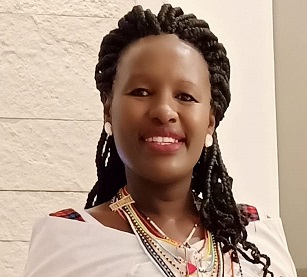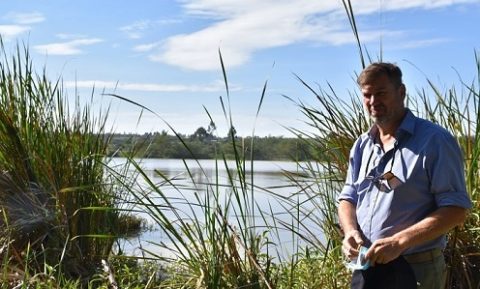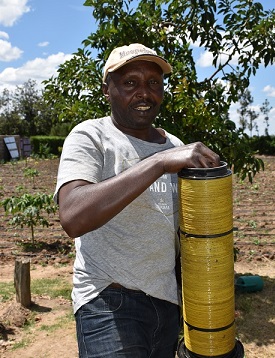Their lives are as different as night and day. A millionaire export flower grower, a small-scale farmer, a nurse who runs a community-based organisation and a pastoralist leader. But they are bound by one thing: water.
“I first saw water running from a tap when I joined a boarding school aged 12. I marvelled at water gushing out of a shower head! To date, there is no tap water in my home area and even ten people can use one cup of water. Those who have water take it for granted,” Jacinta Silakan says.

A nurse by profession, Silakan was born and raised in Doldol in lower Laikipia in semi-arid northern Kenya. Like most Maasai, her father kept livestock and in the dry months of the year, her siblings would have to skip school to drive the cattle to far flung water points.
As a young girl, she would trek two kilometres for two hours in search of water for domestic use. Yet today, women and girls spend 3-4 hours for the same trip as the water volume from Loisukut River has decreased. As the CEO of an organisation that caters for children and mothers affected with disability, her concerns are deeper.
“Water scarcity entrenches marginalisation for youth and persons with disability. The youth have to walk for long distances to water cattle and goats at the expense of schooling. The girls can’t clean up during menses while those with disability are exposed to more risks such as defilement when their mothers are away in search of water,” says Silakan.
Water is gold
Doldol falls at the tail end of Laikipia’s Mt Kenya-Ewaso basin. A vast swath of land drawing water from Mt Kenya and the Aberdare ranges, the basin is a mix of dense forest and scrubland and home to urban dwellers, large scale commercial farmers, small scale farmers, pastoralists and wildlife.
Here, water is gold.
River volumes have been declining steadily over the years, due in part to destruction of the forest catchment, uncontrolled abstraction for irrigation upstream and the ravages of climate change.
It is pastoralists who suffer the most. In semi-arid Doldol, for instance, pastoralists have to make do with earth dams because the rivers and streams are seasonal. During severe droughts, livestock, their main economic mainstay, die and they are forced to share the scarce resource with wildlife – with inevitable conflicts.
Need for Community Sensitisation on Water Resource Management
“The connection between people upstream and those downstream is distant. Sensitisation is needed to cement an understanding that what happens upstream affects the pastoralists downstream, Tim Hobbs, Chairman Mt Kenya Growers Group and CEO of Tambuzi Farm says.

Tim Hobbs harvests water in dams and lagoons to run his commercial farm
While the resource is inadequate to meet the needs of users and wildlife in this region, there are concerns about wastage.
“How efficiently are we using our water? Inefficiency, wrong irrigation technology and wasteful practices should be curbed through education and awareness,” says Hobbs, adding that the potential for commercial agriculture for employment
and economic growth is immense if the resource is conserved and shared equitably.
That would entail protecting catchments and rivers from deforestation, minimising wastage through efficient irrigation technology and investing in rainwater harvesting and storage.

Patrick Maina displays one of the water filters at his farm
Patrick Maina is a Nanyuki-based water technician and farmer. Rain water from the roof of his house is harvested and channelled into storage tanks and water pans. Overflow from the reservoirs is directed onto a field where he grows pasture for hay while household waste water is recycled and channelled to a banana farm. Not a single drop of water is wasted on his farm!
Hobbs’ farm is also a study in efficient water use. His greenhouses collect rainwater which is channelled into dams and lagoons. All run off is collected into a 20-acre dam with a spill over into the Burguret River. This bulk water storage facility is designed to sustain the farm for 90 days thus eliminating need for abstraction when river volumes are low.
Urban dwellers can play their part too by installing push taps which are waste free or making a conscious effort not to leave taps running. It is not only pocket friendly but an act of compassion that can save a life downstream.
Water quality matters too.
“Many urban centres in this region lack sewerage facilities while those that do lack the capacity to remove nitrates and phosphates from sewerage before discharging treated water into rivers. This compromises water quality and thereby hygiene,” says Stanley Kirimi of Mount Kenya Ewaso Water Partnership (MKEWP).
There are also polluters in urban areas who discharge waste into rivers at night because they do not want to invest in septic tanks. Runoff from farms and garages also poisons rivers.
Life means being neighbourly – protecting the wetlands, keeping the rivers flowing and clean, and using and sharing this precious resource responsibly and equitably.
Story by Edward Indakwa and Elizabeth Wamba
